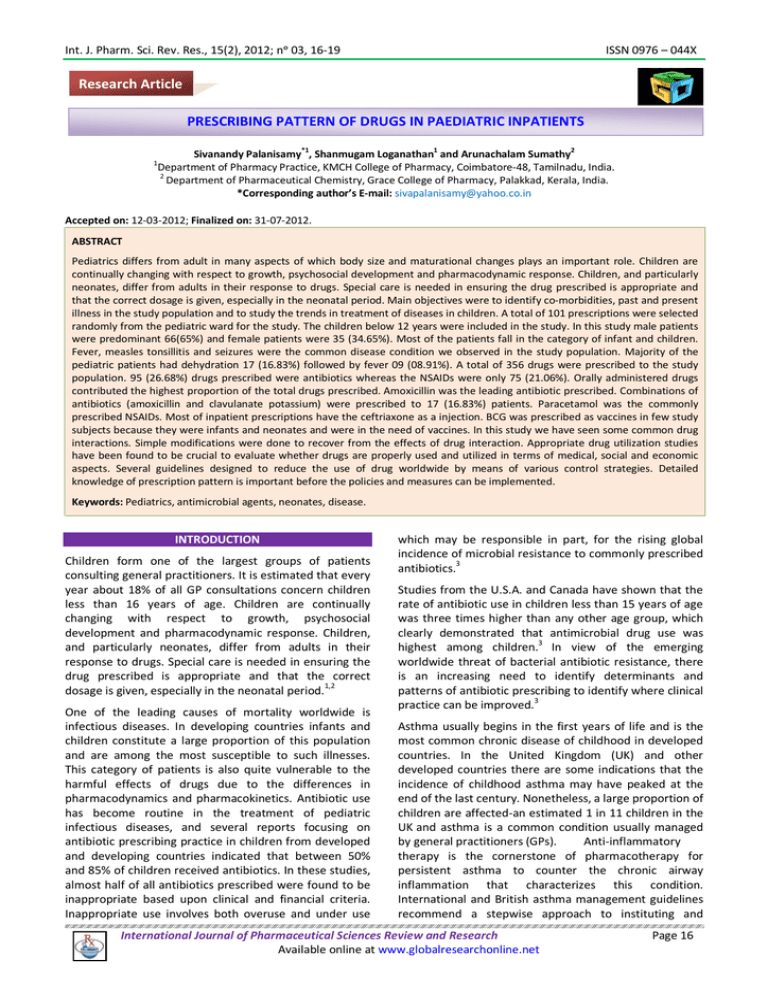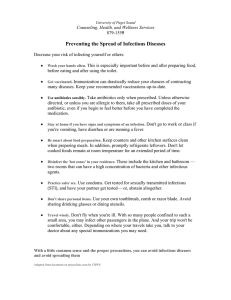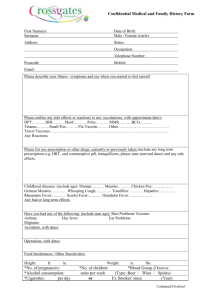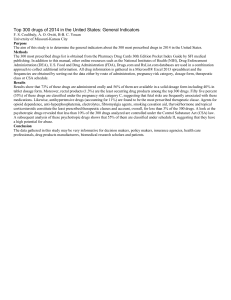Document 13308831
advertisement

Int. J. Pharm. Sci. Rev. Res., 15(2), 2012; nᵒ 03, 16-19 ISSN 0976 – 044X Research Article PRESCRIBING PATTERN OF DRUGS IN PAEDIATRIC INPATIENTS *1 1 1 2 Sivanandy Palanisamy , Shanmugam Loganathan and Arunachalam Sumathy Department of Pharmacy Practice, KMCH College of Pharmacy, Coimbatore-48, Tamilnadu, India. 2 Department of Pharmaceutical Chemistry, Grace College of Pharmacy, Palakkad, Kerala, India. *Corresponding author’s E-mail: sivapalanisamy@yahoo.co.in Accepted on: 12-03-2012; Finalized on: 31-07-2012. ABSTRACT Pediatrics differs from adult in many aspects of which body size and maturational changes plays an important role. Children are continually changing with respect to growth, psychosocial development and pharmacodynamic response. Children, and particularly neonates, differ from adults in their response to drugs. Special care is needed in ensuring the drug prescribed is appropriate and that the correct dosage is given, especially in the neonatal period. Main objectives were to identify co-morbidities, past and present illness in the study population and to study the trends in treatment of diseases in children. A total of 101 prescriptions were selected randomly from the pediatric ward for the study. The children below 12 years were included in the study. In this study male patients were predominant 66(65%) and female patients were 35 (34.65%). Most of the patients fall in the category of infant and children. Fever, measles tonsillitis and seizures were the common disease condition we observed in the study population. Majority of the pediatric patients had dehydration 17 (16.83%) followed by fever 09 (08.91%). A total of 356 drugs were prescribed to the study population. 95 (26.68%) drugs prescribed were antibiotics whereas the NSAIDs were only 75 (21.06%). Orally administered drugs contributed the highest proportion of the total drugs prescribed. Amoxicillin was the leading antibiotic prescribed. Combinations of antibiotics (amoxicillin and clavulanate potassium) were prescribed to 17 (16.83%) patients. Paracetamol was the commonly prescribed NSAIDs. Most of inpatient prescriptions have the ceftriaxone as a injection. BCG was prescribed as vaccines in few study subjects because they were infants and neonates and were in the need of vaccines. In this study we have seen some common drug interactions. Simple modifications were done to recover from the effects of drug interaction. Appropriate drug utilization studies have been found to be crucial to evaluate whether drugs are properly used and utilized in terms of medical, social and economic aspects. Several guidelines designed to reduce the use of drug worldwide by means of various control strategies. Detailed knowledge of prescription pattern is important before the policies and measures can be implemented. Keywords: Pediatrics, antimicrobial agents, neonates, disease. INTRODUCTION Children form one of the largest groups of patients consulting general practitioners. It is estimated that every year about 18% of all GP consultations concern children less than 16 years of age. Children are continually changing with respect to growth, psychosocial development and pharmacodynamic response. Children, and particularly neonates, differ from adults in their response to drugs. Special care is needed in ensuring the drug prescribed is appropriate and that the correct dosage is given, especially in the neonatal period.1,2 One of the leading causes of mortality worldwide is infectious diseases. In developing countries infants and children constitute a large proportion of this population and are among the most susceptible to such illnesses. This category of patients is also quite vulnerable to the harmful effects of drugs due to the differences in pharmacodynamics and pharmacokinetics. Antibiotic use has become routine in the treatment of pediatric infectious diseases, and several reports focusing on antibiotic prescribing practice in children from developed and developing countries indicated that between 50% and 85% of children received antibiotics. In these studies, almost half of all antibiotics prescribed were found to be inappropriate based upon clinical and financial criteria. Inappropriate use involves both overuse and under use which may be responsible in part, for the rising global incidence of microbial resistance to commonly prescribed antibiotics.3 Studies from the U.S.A. and Canada have shown that the rate of antibiotic use in children less than 15 years of age was three times higher than any other age group, which clearly demonstrated that antimicrobial drug use was highest among children.3 In view of the emerging worldwide threat of bacterial antibiotic resistance, there is an increasing need to identify determinants and patterns of antibiotic prescribing to identify where clinical practice can be improved.3 Asthma usually begins in the first years of life and is the most common chronic disease of childhood in developed countries. In the United Kingdom (UK) and other developed countries there are some indications that the incidence of childhood asthma may have peaked at the end of the last century. Nonetheless, a large proportion of children are affected-an estimated 1 in 11 children in the UK and asthma is a common condition usually managed by general practitioners (GPs). Anti-inflammatory therapy is the cornerstone of pharmacotherapy for persistent asthma to counter the chronic airway inflammation that characterizes this condition. International and British asthma management guidelines recommend a stepwise approach to instituting and International Journal of Pharmaceutical Sciences Review and Research Available online at www.globalresearchonline.net Page 16 Int. J. Pharm. Sci. Rev. Res., 15(2), 2012; nᵒ 03, 16-19 adjusting daily controller (preventer) anti-inflammatory therapy, beginning with the dose of inhaled corticosteroid (ICS) appropriate to the severity of asthma.4 Clear communication of medication orders minimizes medication errors. Prescribers are encouraged to use these simple and standardized prescribing guidelines in order to ensure medication orders are clear and that the right drug in the right dose is given to the right patient at the right time, all the time.5 Main objectives of the study were to identify co-morbidities, past and present illness, prescribing pattern of drugs, and trends in the treatment of diseases in children. MATERIALS AND METHODS The study was conducted at a private corporate hospital for a period of six months. The authorization of the Chairman and Medical Director, KMCRET & KMCH were obtained to carry out the study. Inclusion Criteria: Children below 12 years were included in the study. Exclusion Criteria: ICU patients, terminally ill patients were excluded from the study. A separate data entry format was designed. The drug chart was also included in the data entry format. Data were collected from patient’s case sheet and transferred to data entry format for evaluation. The collected data were analyzed for its appropriateness and suitability. Interpretation was made on the collected data. From the data analysis, results were obtained and conclusion was drawn. RESULTS AND DISCUSSION A total of 150 children data’s were screened for this study and 101 data were included, the rest of the data’s were excluded because of lack of information’s. Among the study subjects (n=101), 66 were found to be male and 35 were found to be female. It indicates that 2/3rd of the child patients receiving medical aid in this hospital was male. Table 1: Royal College of Pediatrics and Child Health (RCPCH) Classification of children Age in years No. of children (%) Neonate (birth to 1 month) Sex Distribution (%) Male Female 8 (07.92%) 01(0.99%) 7(6.93%) Infant (1 month to 2 years) 43 (42.57%) 29(28.71%) 14(13.86%) Child (2 to 12 years) 50(49.50%) 36(35.64%) 14(13.86%) As per RCPCH classification, most of the patients were fall in the category of child and the age between 2 and 12 years which is around 50 percent of the total study population. 42.57 percent were infants and 07.92 percent were neonates in this study population. Poor immune system development or under development of immune system in the infant and child group plays a major role in ISSN 0976 – 044X acquiring disease (s) (table 1). All study subjects were admitted in the department of pediatrics, most of the patients in this study fall in the category of infants and children need careful diagnosis and treatment from the pediatrician. Therefore they were admitted in the department of pediatrics for better health care outcomes. Fever was the major reason for admission found in the study population, which was observed in 81 (80.19%) patients, and it is followed by nausea and vomiting in 42, cold and cough in 41 patients. This study was started in the early January, and the climate was very cold with few rainy days, this may be the reason for the children to get fever and cold (table 2). Table 2: Reason for admission of the study population (n=101) S. No 1. 2. 3. 4. 5. 6. 7. 8. 9. 10. 11. 12. 13. 14. 15. 16. 17. 18. 19. 20. 21. 22. 23. 24. 25. 26. 27. Reason(s) Fever Nausea and Vomiting Diarrhea Cold & Cough Swelling of limbs Dysuria Convulsions Abdominal pain Decreased urine output Rash over the body Throat pain Breathing difficulty Ear pain Difficulty in swallowing Hernia Lack of appetite Weakness Wheezing Allergic rhinitis Discharged eyes High colored urine Hematemesis Malena Bed injury Weight loss Snoring Body pain No. of children (%) 81(80.19%) 42(41.58%) 20(19.80%) 41(40.59%) 3(02.97%) 02(01.98%) 06(05.95%) 02(1.98%) 10(9.90%) 4(3.96%) 3(2.97%) 10(09.90%) 5(04.95%) 1(0.99%) 1(0.99%) 07(6.93%) 04(3.96%) 01(0.99%) 01(0.99%) 02(1.98%) 01(0.99%) 01(0.99%) 01(0.99%) 01(0.99%) 01(0.99%) 01(0.99%) 01(0.99%) Among the study population, dehydration was the common disease condition diagnosed, was present in about 16.83 percent of the total study population. Fever, tonsillitis, measles and seizures were the next common condition we observed in the study population. Second phase of the study was carried out in summer season, so the climatic condition in this locality was unfavorable for the children; therefore they developed with dehydration (17; 16.83%), fever (09; 8.91%) and tonsillitis (09; 8.91%). This may be the major reason for increasing admission in this hospital during the study period (table 3). In antibiotics, amoxicillin and ceftriaxone were commonly and equally prescribed and in NSAID’s paracetamol was most commonly prescribed. International Journal of Pharmaceutical Sciences Review and Research Available online at www.globalresearchonline.net Page 17 Int. J. Pharm. Sci. Rev. Res., 15(2), 2012; nᵒ 03, 16-19 ISSN 0976 – 044X Table 3: Diagnosis of diseases in children (n=101) S.No 1. 2. 3. 4. 5. 6. 7. 8. 9. 10. 11. 12. 13. 14. 15. 16. 17. 18. 19. 20. 21. 22. 23. 24. 25. 26. 27. 28. 29. 30. 31. 32. 33. 34. 35. 36. 37. 38. 39. 40. 41. 42. Disease(s) No. of children (%) Fever 09(8.91%) Nephrotic syndrome 01(0.99%) Diarrhea 07(6.93%) Bacteremia 02(1.98%) Infectious enteritis 04(3.96%) Dehydration 17(16.83%) Convulsions/ Seizures 08(7.92%) Gastritis 07(6.93%) UTI 07(6.93%) Viral pyrexia 05(4.95%) Measles 08(7.92%) RTI 03(2.97%) Viral pharyngitis 01(0.99%) Pneumonia 04(3.96%) Sinusitis 05(4.95%) Tonsillitis 9(8.91%) Bronchitis 05(4.95%) Glutamic aciduria 01(0.99%) Hernia 01(0.99%) Rt. Sided supportive parotitis 01(0.99%) Rt. Side empyema 01(0.99%) Rt. UL consolidation 01(0.99%) Cervical lymphadenopathy 01(0.99%) Urticaria 01(0.99%) AR adenoid hypertrophy 01(0.99%) Herpangina 01(0.99%) Early viral exanthematous fever 02(1.98%) Enterocolitis 01(0.99%) Early hemorrhage 01(0.99%) Diokyphoscoliosis 01(0.99%) C5 Absent pedicle 01(0.99%) Head injury 01(0.99%) Dengue fever 01(0.99%)` Acute bacillary dysentery 02(1.98%) Microcephaly 01(0.99%) Global development delay 01(0.99%) Pertusinoid cough 01(0.99%) Leukemia 01(0.99%) Typhoid fever 01(0.99%) Diabetes mellitus 01(0.99%) Brain granuloma 01(0.99%) Facial palsy 01(0.99%) They may be prescribed for the treatment of fever, cold and chill. Anti-emetics (Ondansetron; n=27) and Minerals (Zinc; n=20) were commonly prescribed for the study subjects. BCG was prescribed as vaccines in few of the study subjects because they were infants and neonates and were in the need of vaccines. Anti-histamines and bronchodilator were the other commonly prescribed drugs in the study population (table 4). Majority of the drug interaction found in the study population was moderate + minor, which is followed by Major+ Moderate (n=19; 18.81%), Minor alone (n=16; 15.84%) and Major+ Minor (n=15; 14.85%), etc. Since it was minor and moderate drug interaction, no lethal effects were observed or notified. No adverse drug reactions were observed in the study population (figure 1). Table 4: Distribution of prescribed drugs (n=101) Class of drug, n(%) Antibiotics NSAIDs Narcotic analgesics Diuiretics Anticonvulsant Antimalarials Antiemetics Hypnotics & sedatives Antiulcer Anticoagulants Laxatives Multivitamins Minerals Anthelmentics Vaccines Antihistamines Bronchodilators Electrolytes Antidiabetics Antifungal Nasal drops Topical agents Sympathomimetics Name of the drug Cefixime Amoxicillin Ciprofloxacin Norfloxacin Clavulanate potassium Ofloxacin Cefoperazone Sulbactum Amikacin Erythromycin Ceftriaxone Cefotaxime Cefoperazone Cephalexin Azethromycin Trimethoprim +sulphamethoxazole Cefepime Neomycin sulphate Cefuroxime Cefadroxil Ceftinir Linezolid Paracetamol Diclofenac sodium Ibuprofen Ibuprofen & paracetamol Tramadol HCl Spiranolactone Frusemide Valproic acid Fosphenytoin Chloroquine phosphate Ondansetron Promethazine Domperidone Clobazam Nitrazepam Pantoprazole Lansoprazole Ranitidine Sucralfate Heparin Bisacodyl Vitamin-A Folic acid Zinc Albendazole BCG Hydroxyzine HCl Citrizine HCl Azelastine Chlorpheniramine maleate Dexamethorphan Guaifensin Terbutaline & Bromhexine Phenylpropanolamine Phenylephrine Salbutamol Budesonide Prednisolone Codeine phosphate Formeterol Montelukast Ipratropium bromide Oral Rehydration Salts Insulin Fluconazole Fluticazone NaCl ND Silver sulphadioxide Adrenaline tartarate International Journal of Pharmaceutical Sciences Review and Research Available online at www.globalresearchonline.net No. of children’s (%) 11(10.98%) 17(16.83%) 1(0.99%) 01(0.99%) 12(11.88%) 01(0.99%) 06(5.94%) 06(5.94%) 03(2.97%) 02(1.98%) 17(16.83%) 01(0.99%) 03(2.97%) 01(0.99%) 01(0.99%) 01(0.99%) 01(0.99%) 01(0.99%) 04(3.96%) 03(2.97%) 01(0.99%) 01(0.99%) 65(64.35%) 1(0.99%) 8(7.92%) 1(0.99%) 1(0.99%) 1(0.99%) 1(0.99%) 2(1.98%) 2(1.98%) 04(3.96%) 27(26.73%) 3(2.97%) 1(0.99%) 08(7.92%) 01(0.99%) 03(2.97%) 01(0.99%) 05(4.95%) 02(1.98%) 1(0.99%) 2(1.98%) 2(1.98%) 3(2.97%) 20(19.80%) 2(1.98%) 5(4.95%) 3(2.97%) 7(6.93%) 2(1.98%) 14(13.86%) 3(2.97%) 1(0.99%) 2(1.98%) 3(2.97%) 6(5.94%) 20(19.80%) 05(4.95%) 02(1.98%) 03(2.97%) 01(0.99%) 01(0.99%) 01(0.99%) 06(5.94%) 02(1.98%) 01(0.99%) 01(0.99%) 04(3.96%) 01(0.99%) 01(0.99%) Page 18 Int. J. Pharm. Sci. Rev. Res., 15(2), 2012; nᵒ 03, 16-19 ISSN 0976 – 044X REFERENCES Figure 1. Distribution of drug interactions in children (n=101) 1. Managing Medicines in Schools and Early Years Settings, Dept of Health, March 2005, Available from: www.cornwall.gov.uk/idoc.ashx?docid=06cbd910-09ff...1 2. Prescribing for children, MeReC Bulletin, Vol 11 No 2, 2000. Available from: www.ukmi.nhs.uk/NewMaterial/ html/docs/18060001.pdf 3. Hanneke B. M. Otters, Johannes C. van der Wouden, Francois G. Schellevis, Lisette W. A. van Suijlekom-Smit and Bart W. Koes. Trends in prescribing antibiotics for children in Dutch general practice. Journal of Antimicrobial Chemotherapy. 2004; 53: 361– 366. Available from: http://jac.oxfordjournals.org/content/53/2/361.full.pdf+html 4. Mike Thomas, Tarita Murray Thomas, Tao Fan, Tim Williams and Stephanie Taylor. Prescribing patterns of asthma controller therapy for children in UK primary care: a cross-sectional observational study. BMC Pulmonary Medicine 2010; 10:14712466-10-29. 5. Levine SR, Cohen MR, Blanchard NR et al. Guidelines for preventing medication errors in paediatrics. J Paediatr Pharmacol Ther. 2001; 6: 426-42. Available from: http://www.ppag.org/attachments/files/111/Guidelines_Peds.pdf 5% 4% 12% Major alone 29% Moderate alone 16% Minor alone Major+ Moderate 15% 19% CONCLUSION This study concludes that all the study subjects were admitted in the department of pediatrics for the treatment of fever, cold and chill. Most of the patients fall in the category of infant and children. Fever, cold and cough were the common disease condition we observed in the study population. They were commonly prescribed with antibiotics, antipyretics and analgesics to alleviate the common ailments like fever, cold and pain. Multivitamins also prescribed in many study subjects as nutritious supplements, and they were prescribed with vaccines since they were pediatrics and were in the need of vaccines. Most of the drug interactions were fall in the category of moderate and minor. Simple modifications were done to recover from the effects of drug interaction like reducing or changing the dose, dosage or route of administration of drugs. ************************ International Journal of Pharmaceutical Sciences Review and Research Available online at www.globalresearchonline.net Page 19







